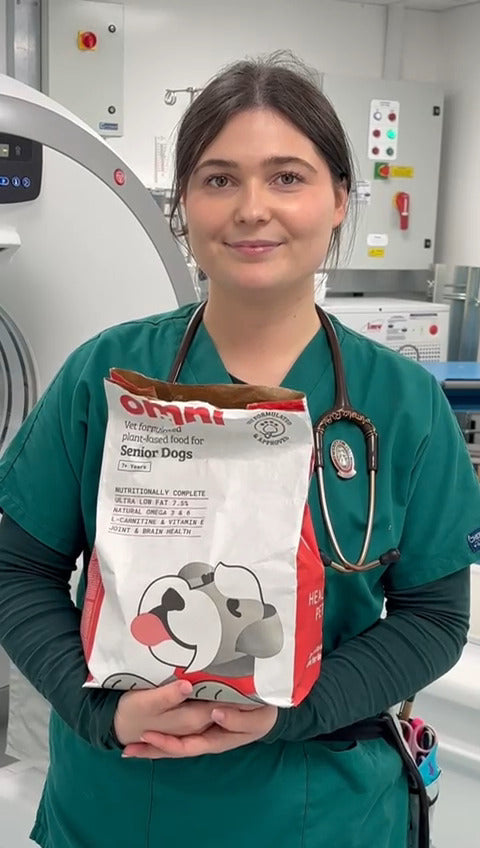Fresh Breath Supplement for Dogs – Keep Your Dog's Breath Minty Clean

Fresh Breath Supplement: Combat ‘Dog-Breath’ and Support Oral Hygiene
According to research, four in five (80%) of dogs over the age of 3 are already suffering the ill effects of periodontal disease, a dental disease caused by the unhygienic build-up of plaques and tartars. And while 57% of dog owners recently surveyed said their dogs had “bad breath”, only 6% were taking any action to improve their companion’s oral hygiene.
That’s why we created our new Fresh Breath Supplement, expertly formulated to tackle doggy breath and promote dental health. With ingredients like Fresh Peppermint, sodium hexametaphosphate (which slow tartar growth & naturally whitens teeth), and plaque-digesting enzymes, this natural, vet-grade 1-a-day soft chew is designed to freshen your dog’s breath and reduce tartar build-up - and give them a dazzling smile to boot!
Perfect for dogs who:
Introduction
Oral health is a key part of your dog’s overall well-being, yet bad breath (or “doggy breath”) is a common issue that many owners face. Our Fresh Breath Supplement was developed by veterinarians to freshen your dog’s breath and maintain dental health. This eco-friendly, animal-free formula works to control plaque, slow tartar build-up, and deliver minty fresh results daily. After a month or three, your dog’s smile will be the talk of the town!
What is the Fresh Breath Supplement?
The Fresh Breath Supplement is a convenient, 1-a-day chew formulated to freshen your dog’s breath and improve oral hygiene. Powered by the natural plaque-digesting properties of Ascophyllum nodosum, Sodium Hexametaphosphate and Fresh Peppermint, this supplement helps slow tartar build-up, support oral hygiene, and reduce bad breath.
Key Benefits:
- Freshens breath and reduces "doggy breath"
- Slows down tartar and plaque build-up
- Supports overall oral and dental health
- Vet-formulated with eco-friendly, animal-free ingredients
Key Ingredients:
- Peppermint (5%): Freshens breath and leaves the mouth feeling clean.
- Sodium Hexametaphosphate (0.67%): Scientifically proven to help slow tartar build-up and reduce plaque on teeth.
- Ascophyllum nodosum (Dried Algae – 11%): A natural source of plaque-fighting enzymes that help break down biofilm on teeth and gums.
- Magnesium Stearate: Supports oral health by contributing to the structure of the supplement.
How Does the Fresh Breath Supplement Work?
Our Fresh Breath Supplement uses a powerful combination of natural ingredients to neutralise bad breath and improve dental health.
- Peppermint: Acts as a natural breath freshener, giving your dog that "just-brushed" freshness.
- Sodium Hexametaphosphate: Binds to calcium in the saliva, preventing the formation of tartar and slowing down plaque accumulation.
- Ascophyllum nodosum (Dried Algae): Provides enzymes that help break down and prevent biofilm, which forms the basis of plaque. By reducing plaque, you also minimize tartar formation, which can contribute to gum disease and bad breath.
Signs Your Dog May Need a Fresh Breath Supplement
Bad breath, or "doggy breath," can be a sign of oral health issues. Look out for the following symptoms that indicate your dog may benefit from our Fresh Breath Supplement:
- Persistent bad breath
- Yellow or brown tartar buildup on teeth
- Red, inflamed gums
- Reluctance to chew or eat food
- Excessive drooling
- Pawing at the mouth
If your dog is showing any of these signs, introducing the Fresh Breath Supplement can help maintain their oral hygiene and freshen their breath.
Success Stories: Fresh Breath for Dogs
"After struggling with Buddy’s bad breath for months, we tried the Fresh Breath Supplement. Within two weeks, we noticed a big difference—his breath is minty fresh, and his gums look healthier too! We’re happy to have found a natural, easy solution."
Vet Recommended: The Science Behind the Fresh Breath Supplement
Our Fresh Breath Supplement is formulated with scientifically-backed ingredients to combat doggy breath and support oral health. Studies show that Sodium Hexametaphosphate can significantly reduce tartar build-up [1], while Ascophyllum nodosum effectively breaks down biofilm to control plaque and reduce bad breath [2]. Peppermint provides immediate fresh breath and contributes to overall mouth cleanliness.
- https://journals.sagepub.com/doi/abs/10.1177/089875649601300105
- https://link.springer.com/article/10.1007/s00784-014-1383-2
How to Use the Fresh Breath Supplement
Using the Fresh Breath Supplement is simple and convenient. Feed it whole, sprinkle it onto your dog's food, or use it as directed by your veterinarian. Always ensure your dog has access to fresh, clean water.
- Feeding Instructions:
- 1 chew per day
- Suitable for dogs from 3 months of age
- Store in a cool, dry place away from direct sunlight
- Once opened, consume within 3 months
Where to Buy the Fresh Breath Supplement
Our Fresh Breath Supplement is available for purchase directly from our website. Enhance your dog’s overall health by pairing it with our Bladder Care Supplement for holistic support.
Chat to one of our vets first.
DisclaimerWhile our Fresh Breath Supplement is formulated to improve your dog's breath and dental health, it’s important to consult your veterinarian if your dog has persistent oral health issues. This product is not suitable for dogs being treated for hyperthyroidism.







 85 Great Portland Street, 1st Floor, London, W1W 7LT United Kingdom
85 Great Portland Street, 1st Floor, London, W1W 7LT United Kingdom